December 6, 2010 at 8:57 pm
(Source: cnet)
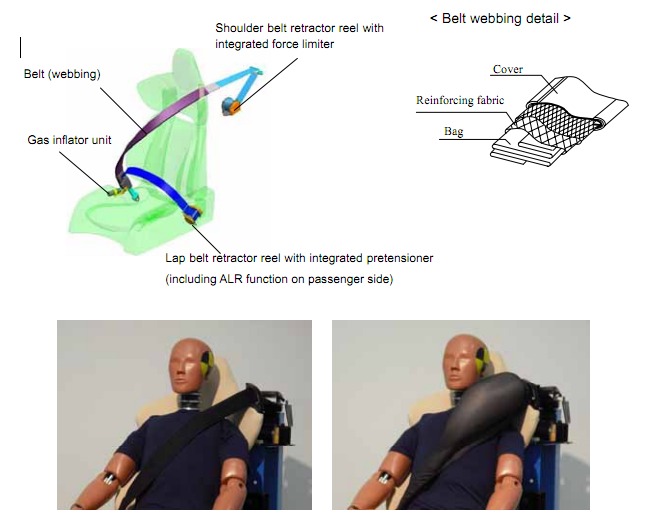
Looks like Toyota is at it again, upping the ante for other players in the automobile market to match the stellar reputation it has built over the years as an advanced engineering shop that leaves no stone unturned to enhance the safety of the riders in the Lexus vehicles. This above featured new, inflatable Takata “Airbelt,” or SRS Seat Belt Airbag, is built into the webbing of the seat belt of the Lexus LFA, the latest out of Toyota’s Lexus stable, expected to hit the market soon. It’s designed to protect drivers and front-seat passengers in front- or side-impact collisions. So, how does it work? Well, it works as shown nicely in the above graphic and here is some additional text from Cnet.com to aid in your understanding:
“The belt expands directly to spread the shock-load over a wider area of the occupant’s chest during front impact. And in a side impact, the belt inflates between the shoulder and head to reduce lateral head movement and provide protection from impact with the side window or colliding object, the company said in a press release.”
Click here to read more.
December 6, 2010 at 3:39 pm
(Source: Copenhagenize via Treehugger)
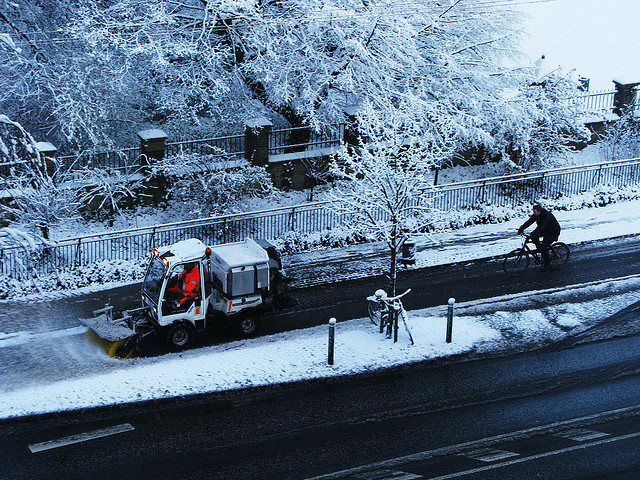
Image courtesy: Mikael Colville-Andersen via Copenhagenize.com
This one image says a thousand words, and many of them indicate how a society is thoughtful, accommodative, encouraging and appreciative of its citizens’ efforts to use alternative modes of transportation, even during the punishing winter weather conditions. Our beloved bike blogger, Mikael Colville-Andersen at Copenhagenize.com, writes about the snow-removal practices in Copenhagen, Denmark, where the focus is also given not only to travel lanes for cars and trucks but also for those bike lanes in the city. Copenhagen, as many of us know, has one of the highest number of bicycle commuters, who regularly use these bike lanes to get around the city. You may ask but why snow-removal for bike lanes is a priority in the winter? Here is what Mikael has to say on his blog about this:
The result? Clear channels on which the bicycle traffic can move. Prioritizing the bike lanes is, of course, a great and necessary way to encourage people to ride bicycles all through the year. On the other hand, it is also a practical necessity. If the bicycle lanes weren’t cleared, a whole lot of people on the day after a snowstorm wouldn’t ride.Tens of thousands. They would seek alternatives. Cars, perhaps, but mostly public transport. Imagine the complications of having tens of thousands of people suddenly show up at train stations and bus stops. A logistical nightmare. So keeping the bike lanes clear is an important factor in keeping Copenhagen moving.
Hope other cities, especially the ones in the US (DC/NYC) realize the importance of keeping the snow off the bike lanes. Click here to read Mikael’s blog post and a few more awesome pictures from his collection.
December 2, 2010 at 5:39 pm
(Source: Bridging the Gap)

The latest edition of the United Nations Climate Change Conference CoP 16 opened its doors in Cancun, Mexico on November 29th (duration – Nov 29th thru Dec 10) and our friends at Transport 2012 have created a compilation of side-events related to transportation issues at this conference. Transportgooru is glad to share this with its readers (hoping some of you are already in Cancun, Mexico attending this event). Please check the Transport2012 website for an updated list:

“Bridging the Gap: Pathways for Transport in the Post 2012 Process‘ is an initiative of GTZ, TRL, UITP, ITDP and Veolia Transport created to tackle CO2emissions from land transport and to integrate this major contributor to climate change into the international climate negotiation process. Click here to learn more about Bridging the Gap.
November 30, 2010 at 2:33 pm
The Santa Cruz County Regional Transportation Commission (RTC) and the Transportation Agency for Monterey County (TAMC) invites interested parties to submit a proposal for developing a Feasibility Analysis and Implementation Plan for a Monterey Bay Area 511 Traveler Information System. The Request for Proposals has been published and can be accessed at the Monterey Bay Area’s 511 project website.

General information is listed below for quick reference:
- Proposal Due Date: Proposals must be submitted no later than 4:00pm, PacificStandard Time, Thursday, January 6, 2011.
- Proposers’ Conference: A proposers’ conference will be held on Monday,December 6, 2010 at 2:00pm in the Santa Cruz Regional Transportation CommissionConference Room, 1523 Pacific Ave., Santa Cruz. Participation will also be available by conference call. To ensure that sufficient resources are available for this meeting, RSVPs to info@sccrtc.org or (831) 460-3200 are requested by Wednesday, December1st at Noon. Please indicate whether you plan to attend in person or by phone.
- Requests for clarification or exceptions: Requests for clarification or exceptions to RFP requirements must be received byRTC no later than 4:00pm on Monday, December 13, 2010 to guarantee response or consideration.
Addenda:
This RFP and any addenda will be posted on the 511 project website(www.511montereybay.org). All potential bidders should review this pageperiodically for any updated information about the Request for Proposals. To receive email notifications of addenda to this RFP, prospective proposers must submit an email request to the RTC Project Manager.
Point of Contact:
Tegan Speiser, Project ManagerSanta Cruz County Regional Transportation Commission1523 Pacific Ave., Santa Cruz, CA 95060831-460-3200 ~ tspeiser@sccrtc.org
November 30, 2010 at 12:01 am
RITA strongly encourages comments on the Real-Time System Management Information Program Final Rule Request:
Rule: http://frwebgate.access.gpo.gov/cgi-bin/getdoc.cgi?dbname=2010_register&docid=fr08no10-4 Comments: http://www.regulations.gov/search/Regs/home.html#submitComment?R=0900006480b84022 BACKGROUND The concept for establishing a Real-Time System Management Information Program was included in federal transportation legislation in 2005 (specifically known as Section 1201 of the Safe, Accountable, Flexible, Efficient Transportation Equity Act: A Legacy for Users, or SAFETEA-LU). The Real-Time System Management Information Program would provide the capability to monitor in real-time the traffic and travel conditions of the major highways across the U.S. and provide a means of sharing these data with state and local governments and with the traveling public. The SAFETEA-LU legislation required the Secretary of Transportation (Secretary) to establish a formal rule in order to define minimum parameters and requirements for states to make available and share traffic and travel conditions information via real-time information programs. The Federal Highway Administration has released the proposed rule, and is seeking comments from stakeholders across the public and private sectors. The Research and Innovative Technology Administration, which oversees the U.S. Intelligent Transportation Systems Program, is actively encouraging innovation in data collection, management, and dissemination across a wide array of communications platforms, and also encourages stakeholders to provide detailed comments regarding this rule. RITA is particularly interested in responses to questions below from the Notice:
- Given the research investment into wireless communications systems in the 5.9 GHz spectrum for Intelligent Transportation Systems applications, to what extent could systems in this spectrum also be used to fulfill the requirements of this rule and/or enable other applications?
- Given that there are legacy technologies in place now, and that there are new technologies on the horizon that are being adopted, how can we ensure that investments made today to comply with this rule are sustainable over the long term?
DATES:
This rule will be effective December 23, 2010. Establishment of the real-time information program for traffic and travel conditions reporting along the Interstate highway system will be completed no later than November 8, 2014. Establishment of the real-time information program for traffic and travel conditions reporting along the State-designated metropolitan area routes of significance will be completed no later than November 8, 2016. We request that comments be submitted via the link above no later than December 23, 2010.
November 27, 2010 at 1:04 pm
(Source: Ebay Motorsblog)
Click Image to Enlarge

November 22, 2010 at 8:52 pm
(source: Washington Post’s Federal Eye)
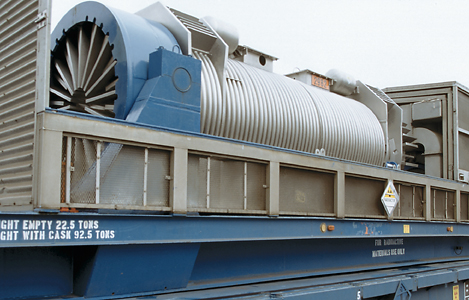
This is very disconcerting, to say the least. But I’m glad at ths ame time they are working to fix the problem.
Federal agents responsible for driving nuclear weapons and other sensitive materials sometimes got drunk and were detained by police while on the job, according to a new watchdog report.
A report released Monday by the Energy Department’s Office of Inspector General found 16 alcohol-related incidents between 2007 and 2009 involving personnel with the National Nuclear Security Administration‘s Office of Surface Transportation (OST). About 600 OST agents are responsible for safely transporting or shipping nuclear weapons and other materials across the country.
Two incidents involved extended overnight missions where OST agents parked convoy vehicles in safe harbor before checking in at nearby hotels, the report said. In separate incidents, an agent was arrested in 2007 for public intoxication while two agents were handcuffed and temporarily detained by police officers in 2009, according to the report.
Click here to read the entire story.

November 22, 2010 at 1:29 am
(Source: Good)
Click Image to Enlarge

Cities with the most frustrating traffic problems
November 21, 2010 at 8:14 pm
(Source: Good)
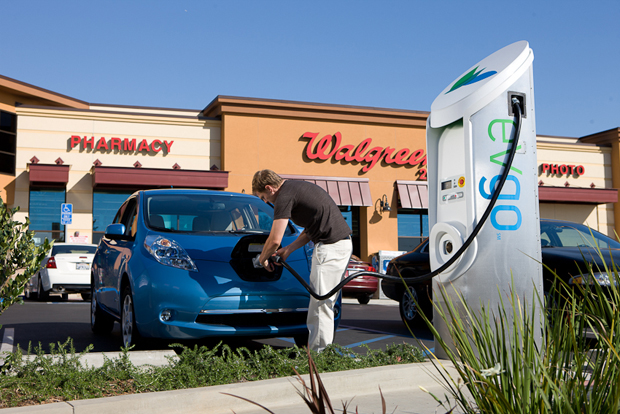
Houston, Texas, may end up being the first American city with a great electric car charging infrastructure. NRG Energy is rolling out what is supposedly the world’s first privately funded comprehensive electric vehicle ecosystem. Here are some interesting nuggets:
- The system (or “ecosystem,” in their overwrought marketing speak), called eVgo, employs a very interesting business model. Subscribers sign a three-year contract and then pay a monthly fee, ranging from $49 to $89, for both a home charger and varying levels of access to this network of public chargers.
- NRG plans to install between 50 and 150 high-speed chargers in public places— shopping centers and the like—by the end of 2011. They’ll also be installing chargers in people’s homes.
- The high-speed chargers distributed around the city can charge a car to 80 percent within 30 minutes.
Click here to read more.

November 20, 2010 at 6:32 pm
(Source: Gizmodo)
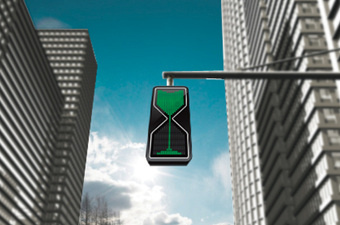
Image Courtesy: Gizmodo
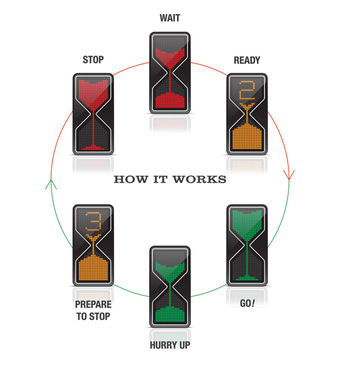
Image Courtesy: Gizmodo
It’s an incredibly simple idea: LED lights trickle down in a virtual sand glass that countdowns how much more Red and Green there will be. When it approaches 3 seconds left, the LEDs switch to yellow and give you an exact count on what’s left.
Click here to read the entire article.


















